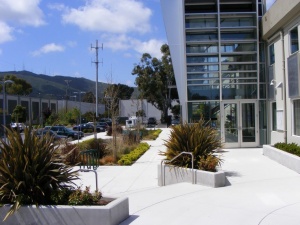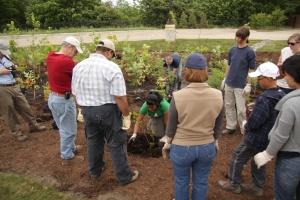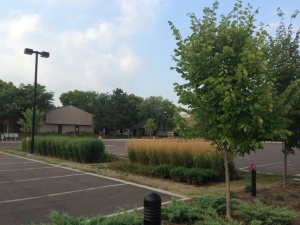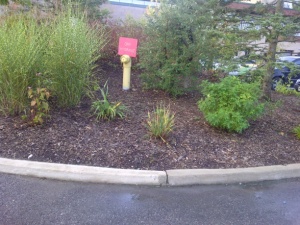Difference between revisions of "Site conditions: public lands"
Jenny Hill (talk | contribs) |
Jenny Hill (talk | contribs) |
||
| Line 56: | Line 56: | ||
pollution prevention. | pollution prevention. | ||
=== Source | === Source areas === | ||
The LID option that best fits your site will depend what types of source areas are present. Types of source areas include: | The LID option that best fits your site will depend what types of source areas are present. Types of source areas include: | ||
*Active use area | *Active use area | ||
Revision as of 13:44, 10 October 2017
Your LID project team[edit]
Whether you are planning a small-scale or large-scale LID retrofit project, your team should be comprised of project champions that promote the retrofit within your municipality and the community. The project manager should be a person who is familiar with the site and its maintenance and operations. The core project team will include a broad range of professionals with different fields of expertise and perspectives to support the project manager.
The core project team develops an overall plan and provides key information to assist the project manager with decision making. The project team also helps to identify staff, external organizations, and stakeholders who can provide information, advice, or professional expertise. For projects that require external support from consultants and contractors, the core team should be able to help with the development of the terms of reference, tender, or request for proposal (RFP).They should also review and comment on site design and assist with construction administration and oversight.
Team members must possess a comprehensive understanding of goals and targets associated with stormwater management, site function, and existing operations and maintenance at the site.
Most municipalities are fortunate to have departments that can support the retrofit process. You may consider looking to the following areas for project support:
- Forestry and parks departments
- Environmental services and stewardship
- Engineering services
- Capital works
- Terrestrial and aquatic services
- Geosciences (hydrology and hydrogeology)
- Marketing and communications departments
- Community services
The size of your team, as well as the type of expertise that is available will depend on the size of your municipality. Small municipalities may not have all the departments listed above. Support from consultants and partnering organization such as conservation authorities can help to get the work done. Operations staff are required team members since they will be most familiar with existing site maintenance practices. These members will have critical first-hand knowledge of what type(s) of LID practices are best suited given current levels of service, or what changes may be required to accommodate new LID retrofits.
Also consider what support or resources your project may receive from:
- Councilors
- Regional government
- Your local conservation authority
- Provincial staff
Forming community partnerships[edit]
Municipal facilities are hubs for community groups, interest clubs and sports teams. Partnerships with these groups can help promote and fund your LID retrofits. Community groups may have an interest in upgrading or beautifying facilities that they commonly use. Volunteer support and even funding from these groups may be possible, especially if the project achieves common goals.
Consultation with the public is probably not needed for projects that are unlikely to affect public use. Examples of LID retrofit projects that do not require public consultation include implementing pollution prevention strategies around maintenance facilities, and installing rain barrels on your roof drains. However, for small-scale practices that are to be integrated into public use areas and have the potential to change usage patterns in the municipal facility, public consultation should occur.
LID opportunities at municipal facilities[edit]
Each distinct area of your site can be a source for runoff (referred to as a ‘source area’). These areas should be targeted when introducing LID in your municipal facility.
Targeting hard surfaces[edit]
Municipal facilities have large parking lots to accommodate public demand. Parking areas represent the most significant source of pollutant loading from these sites and contribute significantly to increased runoff rates in comparison to natural conditions. Parking lots include areas for parking, areas for driving, and islands or landscape planters used for calming traffic, directing vehicles, and improving pedestrian safety.
LID practices can be incorporated into all areas of a parking lot. You can use bioretention in parking lot islands and along the lot perimeter. Standard curbs with small cut-outs (called ‘curb cuts’) can allow water to easily enter biorentention practices while also preventing damage from cars.
Bioswales can also be located in parking lot islands or along lot perimeters. Parking lots with existing perimeter ditching are ideal for bioswale integration due to their extended continuous flow path.
Prefabricated modular infiltration chambers are gaining acceptance for their easy integration with parking lot functions. These subsurface systems are typically installed over a coarse granular reservoir to provide storage and allow infiltration into native soils. Infiltration chambers under conventional asphalt system work well on sites where parking demand and other site uses do not allow space for a stormwater feature.

Permeable paving can also be integrated in large municipal parking lots. Pervious concrete, permeable interlocking concrete pavers, and porous asphalt can detain stormwater and increase infiltration.
There are also excellent opportunities to integrate rainwater harvesting systems in many municipal facilities. Rainwater harvesting systems have two requirements: an area for catchment of relatively clean runoff, and a nearby demand for water usage. Municipal facilities often have large rooftop areas that produce relatively clean runoff. Installing a cistern either internal to the building or buried adjacent to the building can provide a sustainable source of water for site irrigation needs, including landscaped areas and recreational fields, as well as indoor use for flushing toilets and urinals.
Targeting Highly Visible Areas[edit]
If your LID integration strategy involves highly visible LID practices, consider targeting areas with high-volume pedestrian traffic.
Targeting pollution prevention opportunities[edit]
On some municipal sites, pollution prevention techniques and strategies outlined in Chapter 2 are the best approaches to mitigating the environmental impact of your site. Retrofits of municipal works yards require a different approach than other land uses discussed in this guide. Works yards do not offer substantial opportunities for public interaction. LID retrofits should focus primarily on reducing pollution generated on-site. Fuelling stations, waste storage areas, truck washing stations, sand and salt storage, staging areas, and water conveyance features should be targeted for pollution prevention.
Source areas[edit]
The LID option that best fits your site will depend what types of source areas are present. Types of source areas include:
- Active use area
- Passive use area
- Pedestrian walkway
- Internal driveway
- Parking lot
On municipal sites, pollution prevention is often associated with changes to operations and maintenance practices and has not been included in Table 4.3.1. An aerial photo of a park with each of these source areas accompanies Table 4.3.1. Options and implementation strategies for a few of these source areas will give you some ideas for your park site.


